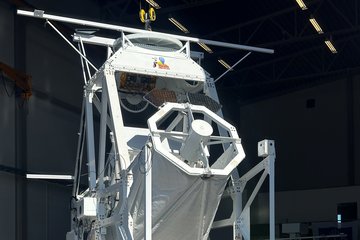All genres
121.
Journal Article
IPS and spacecraft observations relevant to STIP interval IX (15 February - 16 March 1980). preprint (1985)
122.
Journal Article
Doppler Scintillation Observations of Interplanetary Shocks Within 0.3 AU. Journal Geophysical Research 90, pp. 154 - 162 (1985)
123.
Journal Article
Solar radio bursts and in situ determination of interplanetary electron density. Solar Physics 90, pp. 401 - 412 (1984)
124.
Journal Article
Interplanetary Flow Systems Associated with Cosmic Ray Modulation in 1977-1980. Journal Geophysical Research 89, pp. 6579 - 6587 (1984)
125.
Journal Article
Mean Free Paths and Diffusion Coefficients for Energetic Protons at Small Heliodistances Calculated Using Helios 1 and 2 Data. Solar Physics 91, pp. 399 - 413 (1984)
126.
Journal Article
Dynamical evolution of interplanetary magnetic fields and flows between 0.3 AU and 8.5 AU: Entrainment. Geophysical Research Letters 10, pp. 413 - 416 (1983)
127.
Journal Article
On the Equation of State of Solar Wind Ions Derived From Helios Measurements. Journal Geophysical Research 88, pp. 2982 - 2992 (1983)
128.
Journal Article
Determination of the solar wind angular momentum flux from the Helios data - an observational test of the Weber and Davis theory. Astrophysical Journal 271, pp. 335 - 354 (1983)
129.
Journal Article
Direct correlation between coronal transients and interplanetary disturbances. Space Science Reviews 34, pp. 85 - 99 (1983)
130.
Journal Article
A magnetic cloud and a coronal mass ejection. Geophysical Research Letters 9, pp. 1317 - 1320 (1982)
131.
Journal Article
Solar wind helium ions: Observations of the Helios solar probes between 0.3 and 1 AU. Journal Geophysical Research 87, pp. 35 - 51 (1982)
132.
Journal Article
Solar wind protons: Three-dimensional velocity distributions and derived plasma parameters measured between 0.3 and 1 AU. Journal Geophysical Research 87, pp. 52 - 72 (1982)
133.
Journal Article
Observation of flare-generated shock waves by Helios-2 near the sun. Space Science Reviews 32, pp. 131 - 144 (1982)
134.
Journal Article
Magnetic loop behind an interplanetary shock: Voyager, Helios, and IMP 8 observations. Journal Geophysical Research 86, pp. 6673 - 6684 (1981)
135.
Journal Article
Pronounced proton core temperature anisotropy, ion differential speed, and simultaneous Alfvén wave activity in slow solar wind at 0.3 AU. Journal Geophysical Research 86, pp. 9199 - 9203 (1981)
136.
Journal Article
Solar wind and its interactions with the magnetosphere: measured parameters. Advances in Space Research 1, pp. 3 - 17 (1981)
137.
Journal Article
Kalte Schauer von der Sonne. Umschau 81, pp. 438 - 439 (1981)
138.
Journal Article
Interplanetary particles and fields, November 22 to December 6, 1977: Helios, Voyager, and IMP observations between 0.6 and 1.6 AU. Journal Geophysical Research 85, pp. 2227 - 2242 (1980)
139.
Journal Article
Singly-ionized helium in the driver gas of an interplanetary shock wave. Geophysical Research Letters 7, pp. 201 - 204 (1980)
140.
Journal Article
Ion-Acoustic Waves and Related Plasma Observations in the Solar Wind. Journal Geophysical Research 84, pp. 2029 - 2038 (1979)











